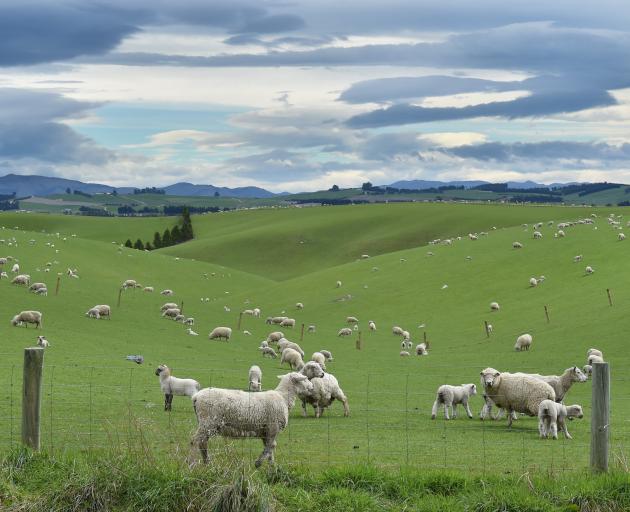
The report, released yesterday, sets the scene for a challenging year with declines predicted in both sheep meat and beef export receipts as the pandemic affects global economies, consumer demand and trading channels.
Lamb export receipts were forecast to drop by almost 15% and co-products to decline about 8% compared with the 2019-20 season. Beef and veal export revenue was predicted to decline by 9%.
The uncertainty in the export market would be reflected in farm-gate prices and subsequent farm profitability,
B+LNZ’s chief economist Andrew Burtt said in a statement.
In Otago-Southland, gross farm revenue was forecast to decrease 9.5% to average $553,200 per farm for 2020-21. The largest drivers were the decreases in sheep and wool because of the significance of sheep in the region. Revenue from wool and sheep combined accounted for nearly 80% of gross farm revenue.
B+LNZ’s chief insights officer Jeremy Baker said the uncertain global picture reinforced the need for stable and predictable domestic regulation to avoid putting further pressure on the red meat sector at a time when its export receipts were critical to New Zealand’s economic recovery.
Despite the challenges, red meat exports were predicted to be more than $9billion and would represent more than 17% of New Zealand’s total export receipts.
Mr Burtt said much of the predicted profit decline was a result of Covid-19, drought affecting production, and increasing competitiveness in key beef export markets.
While there was uncertainty, there were solid underlying market fundamentals that would continue to support demand for New Zealand sheep meat and beef exports.
China’s demand for meat protein continued to be fuelled by pork shortages resulting from African Swine Fever, and there was growing demand for high-quality nutritionally rich proteins. A shifting consumer preference towards food safety would also support demand, he said.
The trading environment would also face ongoing uncertainty around key trade negotiations. Brexit outcomes and the relationship between the United States and China would have an influence on market dynamics in the new season.
Unfortunately, there was little optimism in the outlook for wool. The outlook for the season was for wool exports to decline 2.8% on 2019-20.
Average export receipts at FOB were expected to decrease 34% to $3700 per tonne, following an 18% drop the previous year.
Total wool receipts were forecast to drop 36% on the previous year to an estimated $276million. The estimate for the overall auction wool price was down 20% on 2019-20.
There was little optimism in the outlook for wool prices. The industry was depressed before Covid-19 and the probability of an upturn in the volatile trading environment post-Covid-19 was considered very unlikely by industry participants, the report said.
Wool inventories were building in New Zealand, driven by weak export demand, low export volumes through the Covid-19 lockdown period, and the seasonal pre-lamb shear.
Exporters were facing a very uncertain trading environment, with terms of trade and existing contracts frequently being renegotiated.
Increased demand was required to clear wool stocks. While producers had now signalled a desire to move their product by accepting lower prices at auction, the lack of end-user demand was challenging exporters’ ability to shift product offshore.
Covid-19 had disrupted operation of woollen mills in the EU with production capacities reported to be significantly down. There was also limited demand for carpet-type wools in the current economic climate, with contraction expected in the construction of new buildings, houses and business refurbishments.
The outlook for 2020-21 was for fine wool prices to ease 33%, following a 22% decline the previous season. Medium wool prices were forecast to drop 31% and strong wool prices to decline 35%.
The market was a challenging one to forecast in the current environment and it was hoped there was a demand shift in the outlook period and there was upside to the forecast.
Not all farmers would feel the full impact of the forecast price declines as some had taken the opportunity to commit to longer-term contracts.
China remained New Zealand’s largest wool market region in 2019-20, accounting for 39% of wool export volume, down from 48% in 2018-19.
The cost of shearing continued to lift in the 2019-20 season, with a 1.4% rise recorded. That followed a sharp lift of 11% in shearing costs in 2018-19.
AT A GLANCE
- Total lamb export receipts forecast at $2.94billion FOB, down 14.8% on 2019-20.
- Revenue from co-products forecast to decline 7.9%.
- 2020 lamb crop — estimated to be 22.3million head — is forecast to be 4.2% lower than 2019.
- Mutton export receipts forecast to decline 16%.
- Total export receipts for sheepmeat (lamb and mutton) forecast to decline by 15%, or $622million, to $3.5 billion FOB.
- The weighted average lamb farm-gate price is forecast to be between 620c and 715c per kg.
- Export revenue from beef and veal forecast to be $3.5billion FOB, down 9% on 2019-20.













